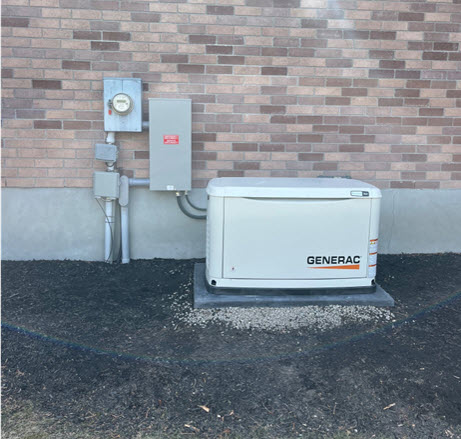18kW Generac Generator Service in Ottawa
Installing, Repairing, and Servicing Generac Guardian Series 18 kW Home Standby Generator
A notch up in size from the popular Generac 14 kW generator, the Generac Guardian Series 18 kW Home Standby Generator is good if you have a larger home or one with higher power consumption. We’ll walk through some of its specs and help you decide whether the Generac 18kW is right for you.
Whatever model of generator you have now or end up with, we can service, repair, or install it for you. We serve all of the Ottawa Valley. Contact Powers Servicing today or read on to find out more.

Power Output: 18 kW
This number reflects the maximum continuous electrical output the generator can provide. An 18 kW generator is typically powerful enough to handle the energy needs of an average to large home. It can run essential systems like lights, the refrigerator, HVAC, and multiple outlets, along with larger appliances such as an electric range and other high-demand devices.
18kW Generac Fuel Type: Liquid Propane or Natural Gas
The generator can run on either liquid propane or natural gas. Liquid propane is stored in tanks, while natural gas is supplied directly from your gas line. Each has its own costs and benefits.
Propane is typically more expensive than natural gas, but has a higher energy density, allowing the generator to reach its full 18 kW output. A benefit of propane is its total independence from utility services. If you already have propane tanks or want complete off-the-grid freedom, liquid propane might be the best option for you.
Natural gas has a slightly lower energy density, causing the generator to run at closer to 17 kW output, depending on the fuel line size and pressure provided to the generator. It is usually more convenient, because there are no tanks and nothing to fill up, as it comes from a continuous supply. However, natural gas supplies can vary, potentially impacting performance. Gas is typically reliable during power outages caused by snow storms or high winds, but the gas supply can be affected by natural disasters like earthquakes, or for maintenance reasons.
Battery Type: Group 26R 540 CCA Minimum or Group 35AGM 650 CCA Minimum
These battery types are common in mid-sized standby generators. They are used in both the Generac 14 kW and the 18 kW.
“CCA” stands for Cold Cranking Amps, meaning the battery’s ability to deliver a certain amount of current at 0°F for 30 seconds without dropping below a specified voltage. This is important for starting the generator reliably in cold weather.
“AGM” stands for Absorbed Glass Mat. These batteries use a special fiberglass mat to hold the electrolyte in place. The design also allows for faster recharging, deeper discharge cycles without damage, and better performance in extreme temperatures compared to traditional flooded batteries. AGM batteries are often preferred for generators operating in colder climates or for users seeking higher performance and less maintenance.
Group 26R 540 CCA Minimum is a more compact, less expensive option, similar to a car battery. It can function reliably in moderately cold temperatures, typically down to around 0°F to -10°F, but may struggle in extreme cold.
Group 35AGM 650 CCA Minimum provides higher cold cranking amps and performs better in very cold conditions, typically maintaining reliable performance in temperatures as low as -20°F to -30°F.
Engine Type: G-Force 800
This engine is built specifically for standby generators. It uses full pressure lubrication, which consistently delivers oil to key engine components, helping the engine run smoothly and reducing wear. This results in less frequent maintenance compared to splash-lubricated, air-cooled engines that are often used in lower-cost generators. The G-Force 800 is reliable and designed for extended operation during power outages.
Generac 18kW Generator Weight: 420 lb
This weight is typical for a mid-sized generator. To function reliably, the generator needs a level foundation, like a concrete or prefabricated composite pad, to prevent shifting or settling over time.
Other Features
True Power™ Technology reduces total harmonic distortion to less than 5%, which is considered the threshold for “clean” power that’s safe for sensitive electronics. In a generator, low total harmonic distortion (THD) means the electricity is smooth and stable, which is important for sensitive devices like computers, TVs, or medical equipment. If the THD is too high, the power can be “jumpy” and cause those devices to overheat, malfunction, or get damaged.
Because this generator has low total harmonic distortion, it’s safer to use on sensitive devices—like computers—than electricity from older or budget generators.
The Quiet-Test™ Self-Test Mode operates at a reduced RPM, typically running at around 1800 RPM, compared to 3600 RPM in traditional testing modes. This lower RPM can reduce noise levels by up to 50%, bringing the generator’s sound output down to about 55-60 decibels, compared to the 70-75 decibels made by traditional test modes. Every standby generator needs to be tested regularly to make sure it works when the lights go out, but not every generator is this quiet while doing it.
Powder-coated aluminum for corrosion resistance. The RhinoCoat™ Enclosure is built to outlast harsh weather. Low-cost generators often use plastic housings or steel enclosures that are less durable or rust over time.
The Evolution™ Controller Multilingual LCD display is a user-friendly control system for monitoring battery status and scheduling maintenance. You’ll never have to guess what a hard-to-read gauge might be saying.
Wi-Fi enabled Mobile Link™ Remote Monitoring allows you to access the generator status from your phone, computer, or tablet so you’re always up to date. Knowing exactly how your generator is operating helps to give peace of mind wherever you might be.
Finally, Generac’s Customer Support Team is always there, on call 24/7/365 from their headquarters in Wisconsin, to answer any questions you may have.
Generac 18 kW Home Standby Generator: Frequently Asked Questions
How do I know the generator will pass local regulations and codes?
The Generac 18 kW generator is designed to be EPA (Environmental Protection Agency) and CARB (California Air Resources Board) compliant, allowing you to use it in areas with strict emissions requirements. It is also ETL and UL 2200 certified, meaning it has passed rigorous safety standards.
Can the 18 kW Generac generator handle running all of my major appliances at once?
The 18 kW generator can run most major appliances simultaneously in an average to large-sized home (typically ranging from 1,800 to 3,500 square feet). It can handle high-wattage devices like central air conditioning, electric ranges, and multiple other appliances at the same time. However, if you have a very large home or exceptionally high power demands—such as extensive electric heating or specialized equipment—you might still need a larger generator.
Not sure what is best? Contact us, and we’ll help you find the ideal generator size based on your specific power needs.
How much does it cost?
$6800 for the generator itself.
A pad for the generator, transfer switch, installation, wiring, and fuel tanks are additional to the generator cost. The exact amount varies depending on your specific situation.
Do you have any payment plans?
Yes, we offer financing. Please contact us for more information.
From the time I first contact you, how long will it take to have the generator installed?
Typically, the installation takes between 4-6 weeks from confirmed purchase to installation. This includes an initial consultation, site evaluation, getting any necessary permits, and scheduling the installation. Installation times can vary depending on your region and the time of year. For a more precise timeline, contact us to go over the details specific to your location and situation.
How often do I need to service the generator, and will it be expensive?
Backup generators like the 18 kW Generac require an initial 25-hour break-in service when new. After that, they need servicing once a year or after every 100 hours of use, whichever comes first. Regular maintenance includes oil and filter changes, air filter replacements, spark plug replacement, valve adjustments, cleaning and waxing of the unit, and testing the generator. The cost of servicing can vary based on your location and the specific generator model.
What happens if there’s a problem with the generator after installation? Is there a warranty?
Generac’s 18 kW generators come with a 5-year limited warranty that covers parts and labor for repairs due to defects or problems under normal use. If an issue arises after installation, you can contact us to assess and repair the unit. Regular maintenance is required to keep the warranty valid.
Can I monitor the generator remotely, especially if I’m not home when the power goes out?
Yes! The 18 kW Generac includes Wi-Fi enabled Mobile Link™ remote monitoring. This lets you monitor the status of your generator from anywhere using a smartphone, tablet, or computer. You can check if the generator is running, review maintenance schedules, and receive alerts about issues, like low fuel or required maintenance.
If the power goes out, could I use the generator to charge my electric vehicle?
You should be able to use an 18 kW generator to charge your electric vehicle (EV), but it depends on the power requirements of your EV and other power consumption. Most EV chargers need around 7-10 kW, so as long as your generator isn’t powering too many other high-demand appliances, it should be able to handle charging the vehicle. Keep in mind that charging times may be longer compared to using grid power, and it’s important to verify the generator’s capacity with the specific requirements of your EV charger.
What type of fuel does the generator use?
Either liquid propane stored in tanks, or natural gas from your home’s gas line.
